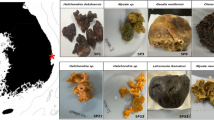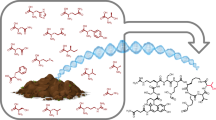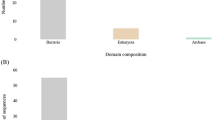Abstract
The biosynthesis of non-ribosomal peptide and polyketide natural products is facilitated by multimodular enzymes that contain domains responsible for the sequential condensation of amino and carboxylic subunits. These conserved domains provide molecular targets for the discovery of natural products from microbial metagenomes. This study demonstrates the application of tag-encoded FLX amplicon pyrosequencing (TEFAP) targeting non-ribosomal peptide synthetase (NRPS) and polyketide synthase (PKS) genes as a method for determining the identity and diversity of natural product biosynthesis genes. To validate this approach, we assessed the diversity of NRPS and PKS genes within the microbiomes of six Australian marine sponge species using both TEFAP and metagenomic whole-genome shotgun sequencing approaches. The TEFAP approach identified 100 novel ketosynthase (KS) domain sequences and 400 novel condensation domain sequences within the microbiomes of the six sponges. The diversity of KS domains within the microbiome of a single sponge species Scopalina sp. exceeded that of any previously surveyed marine sponge. Furthermore, this study represented the first to target the condensation domain from NRPS biosynthesis and resulted in the identification of a novel condensation domain lineage. This study highlights the untapped potential of Australian marine sponges for the isolation of novel bioactive natural products. Furthermore, this study demonstrates that TEFAP approaches can be applied to functional genes, involved in natural product biosynthesis, as a tool to aid natural product discovery. It is envisaged that this approach will be used across multiple environments, offering an insight into the biological processes that influence the production of secondary metabolites.
Similar content being viewed by others
Log in or create a free account to read this content
Gain free access to this article, as well as selected content from this journal and more on nature.com
or
References
Altschul SF, Madden TL, Schäffer AA, Zhang J, Zhang Z, Miller W et al (1997). Gapped BLAST and PSI-BLAST: a new generation of protein database search programs. Nucleic Acids Res 25: 3389–3402.
Banik JJ, Brady SF . (2010). Recent application of metagenomic approaches toward the discovery of antimicrobials and other bioactive small molecules. Curr Opin Microbiol 13: 603–609.
Benson DA, Boguski MS, Lipman DJ, Ostell J . (1997). GenBank. Nucleic Acids Res 25: 1–6.
Blunt JW, Copp BR, Munro MHG, Northcote PT, Prinsep MR . (2006). Marine natural products. Nat Prod Rep 23: 26–78.
Boot CM, Tenney K, Valeriote FA, Crews P . (2006). Highly N-methylated linear peptides produced by an atypical sponge-derived Acremonium sp. J Nat Prod 69: 83–92.
Brady SF, Simmons L, Kim JH, Schmidt EW . (2010). Metagenomic approaches to natural products from free-living and symbiotic organisms. Nat Prod Rep 26: 1488–1503.
Chiang Y-M, Chang S-L, Oakley BR, Wang CC . (2010). Recent advances in awakening silent biosynthetic gene clusters and linking orphan clusters to natural products in microorganisms. Curr opin Chem Biol 15: 137–143.
Craig JW, Chang F-Y, Kim JH, Obiajulu SC, Brady SF . (2010). Expanding small-molecule functional metagenomics through parallel screening of broad-host-range cosmid environmental DNA libraries in diverse Proteobacteria. Appl Environ Microbiol 76: 1633–1641.
De Rosa S, Mitova M, Tommonaro G . (2003). Marine bacteria associated with sponge as source of cyclic peptides. Biomol Eng 20: 311–316.
Donachie SP, Foster JS, Brown MV . (2007). Culture clash: challenging the dogma of microbial diversity. ISME J 1: 97–99.
Edgar RC . (2004). MUSCLE: multiple sequence alignment with high accuracy and high throughput. Nucleic Acids Res 32: 1792–1797.
Fan L, Reynolds D, Liu M, Stark M, Kjelleberg S, Webster N et al (2012). Functional equivalence and evolutionary convergence in complex communities of microbial symbionts. Proc Natl Acad Sci USA 109: E1878–E1887.
Ferrari BC, Winsley T, Gillings M, Binnerup S . (2008). Cultivating previously uncultured soil bacteria using a soil substrate membrane system. Nat Protoc 3: 1261–1269.
Fieseler L, Hentschel U, Grozdanov L, Schirmer A, Wen G, Platzer M et al (2007). Widespread occurrence and genomic context of unusually small polyketide synthase genes in microbial consortia associated with marine sponges. Appl Environ Microbiol 73: 2144–2155.
Finn RD, Clements J, Eddy SR . (2011). HMMER web server: interactive sequence similarity searching. Nucleic Acids Res 39: W29–W37.
Finn RD, Mistry J, Tate J, Coggill P, Heger A, Pollington JE et al (2010). The Pfam protein families database. Nucleic Acids Res 38: D211–D222.
Fisch KM, Gurgui C, Heycke N, van der Sar SA, Anderson SA, Webb VL et al (2009). Polyketide assembly lines of uncultivated sponge symbionts from structure-based gene targeting. Nat Chem Biol 5: 494–501.
Fu J, Wenzel SC, Perlova O, Wang J, Gross F, Tang Z et al (2008). Efficient transfer of two large secondary metabolite pathway gene clusters into heterologous hosts by transposition. Nucleic Acids Res 36: e113.
Fusetani N, Matsunaga S . (1993). Bioactive sponge peptides. Chem Rev 93: 1793–1806.
Guindon S, Lethiec F, Duroux P, Gascuel O . (2005). PHYML Online—a web server for fast maximum likelihood-based phylogenetic inference. Nucleic Acids Res 33: W557–W559.
Hochmuth T, Niederkruger H, Gernert C, Siegl A, Taudien S, Platzer M et al (2010). Linking chemical and microbial diversity in marine sponges: possible role for poribacteria as producers of methyl-branched fatty acids. Chembiochem 11: 2572–2578.
Hochmuth T, Piel J . (2009). Polyketide synthases of bacterial symbionts in sponges—evolution-based applications in natural products research. Phytochemistry (Oxf) 70: 1841–1849.
Howard EC, Sun S, Reisch CR, del Valle DA, Bürgmann H, Kiene RP et al (2011). Changes in dimethylsulfoniopropionate demethylase gene assemblages in response to an induced phytoplankton bloom. Appl Environ Microbiol 77: 524–531.
Huson DH, Mitra S, Ruscheweyh HJ, Weber N, Schuster SC . (2011). Integrative analysis of environmental sequences using MEGAN4. Genome Res 21: 1552–1560.
Jones AC, Monroe EA, Podell S, Hess WR, Klages S, Esquenazi E et al (2011). Genomic insights into the physiology and ecology of the marine filamentous cyanobacterium Lyngbya majuscula. Proc Natl Acad Sci USA 108: 8815–8820.
Keller M, Zengler K . (2004). Tapping into microbial diversity. Nat Rev Microbiol 2: 141–150.
Kennedy J, Codling CE, Jones BV, Dobson ADW, Marchesi JR . (2008). Diversity of microbes associated with the marine sponge, Haliclona simulans, isolated from Irish waters and identification of polyketide synthase genes from the sponge metagenome. Environ Microbiol 10: 1888–1902.
Moffitt MC, Neilan BA . (2003). Evolutionary affiliations within the superfamily of ketosynthases reflect complex pathway associations. J Mol Evol 56: 446–457.
Newman DJ, Cragg GM . (2012). Natural products as sources of new drugs over the 30 years from 1981 to 2010. J Nat Prod 75: 311–335.
Piel J . (2002). A polyketide synthase-peptide synthetase gene cluster from an uncultured bacterial symbiont of Paederus beetles. Proc Natl Acad Sci USA 99: 14002–14007.
Piel J, Hui D, Fusetani N, Matsunaga S . (2004a). Targeting modular polyketide synthases with iteratively acting acyltransferases from metagenomes of uncultured bacterial consortia. Environ Microbiol 6: 921–927.
Piel J, Hui D, Wen G, Butzke D, Platzer M, Fusetani N et al (2004b). Antitumor polyketide biosynthesis by an uncultivated bacterial symbiont of the marine sponge Theonella swinhoei. Proc Natl Acad Sci USA 101: 16222–16227.
Pimentel-Elardo SM, Grozdanov L, Proksch S, Hentschel U . (2012). Diversity of nonribosomal peptide synthetase genes in the microbial metagenomes of marine sponges. Mar Drugs 10: 1192–1202.
Rausch C, Hoof I, Weber T, Wohlleben W, Huson D . (2007). Phylogenetic analysis of condensation domains in NRPS sheds light on their functional evolution. BMC Evol Biol 7: 78.
Rice P, Longden I, Bleasby A . (2000). EMBOSS: the European molecular biology open software suite. Trends Genet 16: 276–277.
Roongsawang N, Lim SP, Washio K, Takano K, Kanaya S, Morikawa M . (2005). Phylogenetic analysis of condensation domains in the nonribosomal peptide synthetases. FEMS Microbiol Lett 252: 143–151.
Schirmer A, Gadkari R, Reeves CD, Ibrahim F, Delong EF, Hutchinson CR . (2005). Metagenomic Analysis Reveals Diverse Polyketide Synthase Gene Clusters in Microorganisms Associated with the Marine Sponge Discodermia dissoluta. Society 71: 4840–4849.
Schloss PD, Westcott SL . (2011). Assessing and improving methods used in operational taxonomic unit-based approaches for 16S rRNA gene sequence analysis. Appl Environ Microbiol 77: 3219–3226.
Schloss PD, Westcott SL, Ryabin T, Hall JR, Hartmann M, Hollister EB et al (2009). Introducing mothur: open-source, platform-independent, community-supported software for describing and comparing microbial communities. Appl Environ Microbiol 75: 7537–7541.
Schmitt I, Kautz S, Lumbsch HT . (2008). 6-MSAS-like polyketide synthase genes occur in lichenized ascomycetes. Mycol Res 112: 289–296.
Siegl A, Hentschel U . (2010). PKS and NRPS gene clusters from microbial symbiont cells of marine sponges by whole genome amplification. Environ Microbiol Rep 2: 507–513.
Siegl A, Kamke J, Hochmuth T, Piel J, Richter M, Liang C et al (2011). Single-cell genomics reveals the lifestyle of Poribacteria, a candidate phylum symbiotically associated with marine sponges. ISME J 5: 61–70.
Sogin ML, Morrison HG, Huber JA, Welch DM, Huse SM, Neal PR et al (2006). Microbial diversity in the deep sea and the underexplored ‘rare biosphere’. Proc Natl Acad Sci USA 103: 12115–12120.
Stachelhaus T, Mootz HD, Bergendahl V, Marahiel MA . (1998). Peptide bond formation in nonribosomal peptide biosynthesis catalytic role of the condensation domain. J Biol Chem 273: 22773–22781.
Sun Y, Wolcott RD, Dowd SE . (2011). Tag-encoded FLX amplicon pyrosequencing for the elucidation of microbial and functional gene diversity in any environment. Methods Mol Biol 733: 129–141.
Swingley WD, Chen M, Cheung PC, Conrad AL, Dejesa LC, Hao J et al (2008). Niche adaptation and genome expansion in the chlorophyll d-producing cyanobacterium Acaryochloris marina. Proc Natl Acad Sci USA 105: 2005–2010.
Taylor MW, Tsai P, Simister RL, Deines P, Botte E, Ericson G et al (2012). ‘Sponge-specific’bacteria are widespread (but rare) in diverse marine environments. ISME J 7: 438–443.
Thomas TRA, Kavlekar DP, LokaBharathi PA . (2010). Marine drugs from sponge-microbe association—a review. Mar Drugs 8: 1417–1468.
Trindade-Silva AE, Rua CP, Andrade BG, Vicente AC, Silva GG, Berlinck RG et al (2012). Polyketide synthase gene diversity within the endemic sponge Arenosclera brasiliensis microbiome. Appl Environ Microbiol 79: 1598–1605.
Varaljay VA, Howard EC, Sun S, Moran MA . (2010). Deep sequencing of a dimethylsulfoniopropionate-degrading gene (dmdA) by using PCR primer pairs designed on the basis of marine metagenomic data. Appl Environ Microbiol 76: 609–617.
Walsh CT, Fischbach MA . (2010). Natural products version 2.0: connecting genes to molecules. J Am Chem Soc 132: 2469–2493.
Ziemert N, Podell S, Penn K, Badger JH, Allen E, Jensen PR . (2012). The Natural Product Domain Seeker NaPDoS: A Phylogeny Based Bioinformatic Tool to Classify Secondary Metabolite Gene Diversity. PLoS ONE 7: e34064.
Acknowledgements
We would like to acknowledge the financial support from the Australian Research Council and the Gordon and Betty Moore Foundation.
Author Contributions
JNW, MVB and BAN designed research; JNWand LF performed research; JNW, MVB, LF, TT and BAN analysed data; and JNW, MVB, TT and BAN wrote the manuscript.
Author information
Authors and Affiliations
Corresponding author
Ethics declarations
Competing interests
The authors declare no conflict of interest.
Additional information
Supplementary Information accompanies this paper on The ISME Journal website
Rights and permissions
About this article
Cite this article
Woodhouse, J., Fan, L., Brown, M. et al. Deep sequencing of non-ribosomal peptide synthetases and polyketide synthases from the microbiomes of Australian marine sponges. ISME J 7, 1842–1851 (2013). https://doi.org/10.1038/ismej.2013.65
Received:
Revised:
Accepted:
Published:
Issue date:
DOI: https://doi.org/10.1038/ismej.2013.65
Keywords
This article is cited by
-
Next Generation High Throughput Sequencing to Assess Microbial Communities: An Application Based on Water Quality
Bulletin of Environmental Contamination and Toxicology (2021)
-
Localized production of defence chemicals by intracellular symbionts of Haliclona sponges
Nature Microbiology (2019)
-
A computationally simplistic poly-phasic approach to explore microbial communities from the Yucatan aquifer as a potential sources of novel natural products
Journal of Microbiology (2016)
-
Culture-independent discovery of natural products from soil metagenomes
Journal of Industrial Microbiology and Biotechnology (2016)
-
The integration of sequencing and bioinformatics in metagenomics
Reviews in Environmental Science and Bio/Technology (2015)



